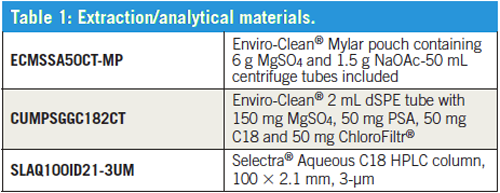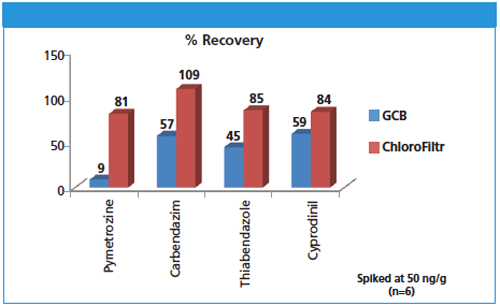Determination of Pesticide Residues in Blueberries by AOAC QuEChERS Approach and Dispersive SPE Cleanup with a Novel Sorbent ChloroFiltr®
The Application Notebook
This application outlines a simple, fast, and cost-effective method for the determination of 34 multi-class pesticides, including one of the most problematic pesticides, pymetrozine in blueberries.
Xiaoyan Wang, UCT, LLC
This application outlines a simple, fast, and cost-effective method for the determination of 34 multi-class pesticides, including one of the most problematic pesticides, pymetrozine in blueberries. The acetate buffered AOAC QuEChERS protocol demonstrated higher extraction efficiency for pymetrozine than the other two QuEChERS protocols (the EN citrate buffered or the original unbuffered), and thus was selected for the extraction of pesticide residues in blueberries. UCT’s Aqueous C18 HPLC column was used for analyte analysis, which demonstrated enhanced retention for several polar pesticides, such as methamidophos and acephate.

QuEChERS Procedure
a) Weigh 15 ± 0.3 g of homogenized blueberry sample into 50-mL centrifuge tubes.
b) Add triphenyl phosphate (TPP) as internal standard (IS) (optional), and appropriate amounts of spiking solution to fortified samples.
c) Add 15 mL of MeCN with 1% HAc. Cap and shake for 1 min at 1000 strokes/min using a Spex 2010 Geno-Grinder.
d) Add salts (6 g MgSO4 and 1.5 g NaOAc) from pouch (ECMSSA50âCT-MP) to the 50-mL tube and vortex for 10 s to break up salt agglomerates.
e) Cap and shake for 1 min at 1000 strokes/min using the GenoâGrinder.
f) Centrifuge at 3000 rcf for 5 min.
dSPE Cleanup
g) Transfer 1 mL of the supernatant to a 2-mL dSPE tube containing 150 mg MgSO4, 50 mg of PSA, 50 mg C18, and 50 mg ChloroFiltr® (CUMPSGGC182CT).
h) Shake 1 min at 1000 strokes/min using the Geno-Grinder.
i) Centrifuge at 3000 rcf for 5 min.
j) Transfer 0.2 mL of the cleaned extract into a 2-mL auto-sampler vial; add 0.2 mL of DI water, and vortex for 30 s.
Instrumental
LC–MS–MS: Thermo Scientific Dionex Ultimate 3000® LC System/ Thermo Scientific TSQ Vantage tandem MS
Column: 100 × 2.1 mm, 3-μm UCT Selectra® aQ C18 LC column
Guard column: 10 × 2.0 mm, 3-μm UCT Selectra® aQ C18 guard column
Injection volume: 2 μL
Mobile phase A: 10 mM ammonium acetate in DI water
Mobile phase B: 0.1% formic acid in methanol
Column flow rate: 0.30 mL/min
Results
Excellent recoveries ranging from 81.3% to 108.7% were obtained for the determination of 34 multi-class pesticides in blueberries. Dispersive SPE cleanup using just PSA or a PSA/C18 combination was ineffective in removing all the pigments in the blueberry extract. The addition of GCB or UCT’s patented ChloroFiltr® in the dSPE tube resulted in a much cleaner extract; however, GCB was detrimental to the recoveries for several planar pesticides including pymetrozine, carbendazim, thiabendazole, and cyprodinil. The recovery data of GCB versus ChloroFiltr® is shown below.
Figure 1: Recovery data of GCB versus ChloroFiltr®.

Conclusion
This application demonstrated the successful extraction of 34 multiâclass pesticides in blueberries using UCT’s QuEChERS extraction kit (ECMSSA50CT-MP) and dispersive SPE cleanup products (CUMPSGGC182CT) in conjunction with the Selectra® aQ C18 HPLC column (SLAQ100ID21-3UM).

Determining Enhanced Sensitivity to Odors due to Anxiety-Associated Chemosignals with GC
May 8th 2025Based on their hypothesis that smelling anxiety chemosignals can, like visual anxiety induction, lead to an increase in odor sensitivity, a joint study between the University of Erlangen-Nuremberg (Erlangen, Germany) and the Fraunhofer Institute for Process Engineering and Packaging (Freising, Germany) combined behavioral experiments, odor profile analysis by a trained panel, and instrumental analysis of odorants (gas chromatography-olfactometry) and volatiles (gas chromatography-mass spectrometry).
Investigating 3D-Printable Stationary Phases in Liquid Chromatography
May 7th 20253D printing technology has potential in chromatography, but a major challenge is developing materials with both high porosity and robust mechanical properties. Recently, scientists compared the separation performances of eight different 3D printable stationary phases.
Detecting Hyper-Fast Chromatographic Peaks Using Ion Mobility Spectrometry
May 6th 2025Ion mobility spectrometers can detect trace compounds quickly, though they can face various issues with detecting certain peaks. University of Hannover scientists created a new system for resolving hyper-fast gas chromatography (GC) peaks.

.png&w=3840&q=75)

.png&w=3840&q=75)



.png&w=3840&q=75)



.png&w=3840&q=75)










